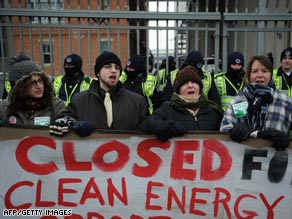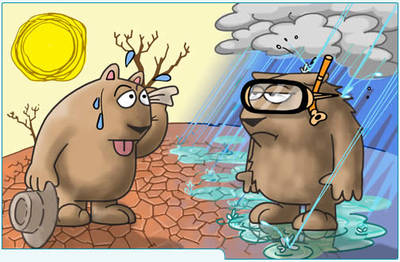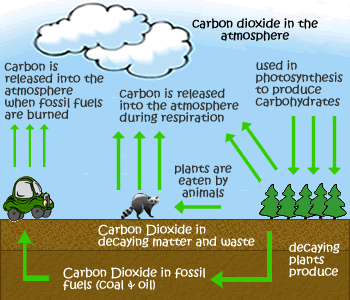In the distant past, climate change was caused mainly by solar output and volcanic eruptions. But in the recent centuries, on top of those natural factors, human-generated impacts have been playing an influential role in contributing to climate change. Even though there is still a small number of people who do not believe that climate change is man-made like Sarah Palin has expressed her opinion in public, the fact cannot be denied.
How humans are affecting the climate is complicated, but mainly through the following three ways: by changing the properties of the underlying surface, by changing some compositions in the atmosphere such as carbon doixide and particles; and also by releasing energy artificially (from my high school geography class). The outcomes of each of these influences are different, some will increase or decrease the temperature, and some will make the atmosphere wetter or drier. But when they mix together with natural factors, each of them influence each other which makes climate change more unpredictable.

This graph is a reservation made by Mauna Loa in Hawaii showing there has been a 2 ppm increase in atmospheric carbon dioxide since 1958. The Fouth Assessment Report of IPCC shows how humans have been affecting the climate by indicating that carbon dioxide levels have greatly increased since the Industrail Revolution and most of it comes from the burning of fossil fuels. From the book Dire Predictions, fossil fuel burning is considered the primary human impact on climate change whereas industrial aerosols comes the second.
Carbon dioxide has been the most discussed topic when it comes to climate. A study showed that carbon dioxide pollution would even result in people’s deaths. “The deaths were due to lung and heart ailments linked to ozone and polluting particles in the air, which are spurred by carbon dioxide that comes from human activities.” Some people might argue that carbon cycle would help eliminate the effect carbon dioxide has brought. Even though plants and water can help absorb carbon dioxide, the amount released in the air outweighs the amount the earth can take.

Early this year, there were organizations protesting in front of the capitol and rallying to reduce carbon emissions and high dependence on coal and oil. Protestants were holding signs saying “coal is dirty,” and expressing the concerns of if the legislation could not even eliminate the use of the coal, it would not be a convincing way for them to believe that the government was actually going to carry out laws to promote sustainable energy use. Actually, being the largest greenhouse gases emitters, both China and the US are facing the same situation when it comes to the reliance on coal. Coal is accelerating global warming, polluting our water and air, and destroying our living environment. Countries have been acting fast in developing alternative and green energy use, and this might be the best way to stop global warming from worsening.
Tags: Carbon Dioxide, climate change
 ” There is no uncertainty at all that humans have significantly altered the global atmospheric concentrations of gases we know to be critical in controlling climate…”
” There is no uncertainty at all that humans have significantly altered the global atmospheric concentrations of gases we know to be critical in controlling climate…”
– October 6, 1997 , distinguished scholar Dr. John P. Holdren at the White House
“We need President Obama to step up and say, ‘I need an economywide emissions cap,’ ” said Andrew Deutz, director of the Nature Conservancy’s international government relations program. “ ‘I need money to negotiate. I need Waxman-Markey passed by X date so I can go to Copenhagen and negotiate.’ ”
-September 22, 2009 New York Times article on recent UN Conference
What is the evidence that humans are a significant cause of the recent climate changes?
Why are we still asking this question?
Michael Mann and Lee Kump give several pieces of evidence of anthropogenic influences on climate change in their book Dire Predictions: Understanding Global Warming. First, if we look at the utilization rates of fossil-fuel burning, we can see correlations in increases of atmospheric CO2. Also, radiocarbon has been decreasing (as made evident by tree rings) so we know that the increases in atmospheric CO2 are coming from “radiocarbon-dead” sources. The most prominent “radiocarbon-dead” sources are volcanoes, deep oceans, and fossil-fuels. Other indicators of anthropogenic influence are the ratio of carbon-13 to carbon-12 (which has been decreasing, therefor ruling out natural, non-plant derived carbon sources such as volcanoes and oceans). Lasly, as used by the IPCC in their most recent findings, the use of “fingerprints” to find spatial patterns help identify underlying impacts (natural and human).
Tags: IPCC, leadership, US Energy Policy

Climate change is a dividing issue. It is not intuitive. It potentially hurts different groups with different interests. Recently I read a research paper by Jack Hollander, a UC Berkeley professor, titled Global Warming: Both sides, Rushing to Judgment. One sentence in its first paragraph captures the main point of the paper: “…hard evidence for human contribution simply does not exist; the evidence we have is suggestive at best”. The paper mostly points out our limited understanding about climate as a reason not to jump to the conclusion that global warming is resulted from human activities and to take actions based on that conclusion. Just from a critical reasoning standpoint, I don’t agree with this argument. In the lack of absolute evidence, it is better to act based on what we already know than to wait until negative consequences are irreversible.
Reading Dire Predictions by Michael Mann and Lee Kump, even after reading Hollander’s, is still very convincing.
Mann and Kump, mindful of counter-arguments, provided a simple and concise account of climate change. The authors mentioned five pieces of evidence why climate change is related to human activities. I am listing them below in order of how convincing there are and why some are not so persuasive.
– Increase in anthropogenic gases over the recent centuries: the evidence was found in changing compositions of the air bubbles trapped in arctic ice. Recent air bubbles contain much more CH4 and N2O than those found at any other time. This is highly convincing because only human activities can account for such significant increases in those gases. For the past 10000 years that we had data for, in no other periods did the atmosphere contain such high percentage of CH4 and N2O. A separate research also on ice core by a team of European researchers published in Science magazine concluded that “CO2 levels today are 27% higher than they have been in the last 650,000 years and levels of methane are 130% higher”.
– Decrease in composition of carbon-13 isotopes in atmosphere: carbon 12 isotopes which are typical of organic matter accounts for an increasing percentage in the atmosphere as compared to carbon-13 isotope. The evidence is convincing because it rules out all other significant sources of CO2 emissions such as volcanic explosion. CO2 from such sources would have higher percentage of carbon-13 isotopes.
– Decrease in radioactivity of CO2 in new tree rings: this means the atmosphere contains much more CO2 from radiocarbon-dead sources such as fossil fuels. Possible counter-point: it is natural that radioactive materials lose their radioactivity levels over time. Maybe natural CO2 loses radioactivity level over time? There is another research I encountered that also used tree rings to measure climate change (see video at the end). It pointed out the fact that rings are further apart in recent years, indicating longer warmer seasons. One disadvantage about studying tree rings is that it is hard to find samples that date back to a very long time ago, limiting evidence of patterns.
– CO2 from human activities more than accounts for CO2 increase: estimated CO2 since industrialization is about twice the increase of CO2 in the atmosphere, but offset by forest and ocean. Possible counter-point: can it be that the ocean actually absorbs more CO2 than that and there is another significant source of CO2?
– Climate model does not correlate with observation without accounting for human impact: Mann and Kump reason that if we do not consider impact of human activities, results from climate models do not match reality. Possible counter-point: from the visual presentation in Dire Prediction, even after adding human impact, the result the prediction is still very different from real observation. Can there be a flaw in the model or a failure to include some important climate processes?
Tags: anthropogenic, human induced climate change, Luan Nguye
How can we be sure that it is humans driving climate change?
It’s simple, look at all possible natural causes and weigh them against the evidence of the latest changes.
In other words, compare the possible and measurable effects of any given “natural” cause of climate change with the actual climate change. Then compare the effects of human activity on climate with the documented changes in climate change.
“Natural” cause here refers to anything other than the result of a human-driven activity.
So what are the possible natural causes for global climate change?
1.- Changes in solar output
2.- Explosive volcanic activity
These two have been carefully observed, and there is a general consensus among scientists that neither one of these is driving the current trends in climate change.
What has been driving it, is an increase in carbon dioxide release into the atmosphere.
Some may argue that there are natural events which result in increased release of CO2 into the atmosphere. While this is indeed true, the dramatic increase in CO2 output and consequent spike in atmospheric concentrations of the gas cannot be wholly accounted for by just looking at natural events.
When CO2 emissions into the atmosphere driven by human activity (= fossil fuel burning) are taken into consideration, it is clear that they are the primary source of the spike in CO2 concentration in the atmosphere.
The correlation between CO2 emissions and change in global temperatures is clear, and the bulk of the CO2 emissions can be traced back to human activity.
Here is a video interview with James Hansen, one of the first scientists to publicly warn of the effects of CO2 emissions on global climate change:
Tags: Andrea Dominguez, anthropogenic, climate change, human-induced, solar output, volcanic activity
There is no debate among scientists as to whether global warming is happening nor if humans have contributed to this.
Global warming is happening. Humans are a significant cause in recent global changes.
The IPCC’s (Intergovernmental Panel on Climate Change) Fourth Assessment Report offers significant evidence of human induced climate change:
- CO2 levels have increased significantly since the Industrial Revolution
- CO2 released from burning fossils fuels more than accounts for the level of CO2 in the atmosphere. Recent CO2 levels in the atmosphere only account for half of what has been released from fossil fuels. The other half has been sequestered in the earth.
- Carbon that comes from the burning of fossil fuels is significantly higher than the carbon that comes from volcanic eruptions or deep ocean sources.
- Only climate models that include natural and anthropogenic factors predict the changes in climate that we’ve seen. Natural factors alone, underestimate these effects.
Here is a YouTube video about human interaction with global warming and their effects on the climate–> The Human Role in Climate Change
You might be thinking.. but what about the carbon cycle? Doesn’t the CO2 we use just get passed along to the next stage in the cycle?
The answer is yes, the CO2 does cycle. The problem is that humans are releasing CO2 faster than it can be re-sequestered. Humans are not in fact creating greenhouse gasses, we are just putting the greenhouse gasses into the atmosphere more quickly than the oceans, soils, and plants can absorb them.
The natural cycle of carbon has a relatively even trade-off between emissions and sequestration (compared to that with human intervention). Volcanic and deep sea sources of carbon can cause a disturbance in this cycle, but as the evidence points out, these sources have not contributed to the recent rise in CO2 levels.
Without human intervention, the natural carbon fluctuations would not see the extremes that we see today. Human intervention has lead to increases in CO2 levels through disturbances in the natural processes or carbon.
Tags: Carbon Sequestration, Grace Lange, human induced climate change


Your Comments